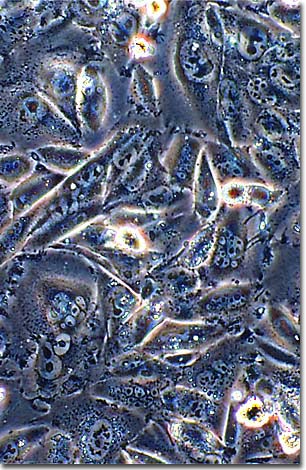Phase Contrast Image Gallery
Chinese Hamster Ovary Cells
This monolayer tissue culture of Chinese hamster ovarian fibroblast cells was photographed in a plastic culture vessel with phase contrast optics using an Olympus inverted microscope.

Most animal cells display a finite lifetime when isolated and grown in a tissue culture medium that supplies necessary nutrients, salts, and vitamins. Typical vertebrate cells divide between 50 and 100 times before they fail to continue cell division and eventually die. Many theories suggest that this limited life span is related to the corresponding life cycle of the parent organism from which the cultured cells were derived.
Occasional changes in the genetic makeup of cultured cells allow them to propogate indefinitely, making them effectively immortal. Such lines are said to be transformed, and are often used in research as a standardized cell line. Chinese hamster ovary (CHO) cells were introduced in the early 1960s as a viable epithelial cell line containing twin female X chromosomes. The most common variety of CHO cells has a nutritional requirement for the amino acid proline, which makes this cell line an ideal candidate for genetic studies.
BACK TO THE PHASE CONTRAST GALLERY
